BMP3004 World of Work: Analyzing Employee Motivation Factors
VerifiedAdded on 2023/06/18
|8
|2002
|229
Report
AI Summary
This report delves into the multifaceted nature of employee motivation, examining both intrinsic and extrinsic factors that drive individuals in the workplace. It references Maslow's hierarchy of needs and Herzberg's two-factor theory to analyze motivational elements such as salary, promotion opportunities, and the work environment. The report further identifies positive aspects like learning opportunities and strong communication channels, as well as negative factors like workplace stress. Strategies for mitigating negative influences, including workplace equality, growth opportunities, and recognition, are discussed, emphasizing the importance of a positive and supportive work environment to enhance productivity and employee satisfaction. The document is contributed by a student and available on Desklib, a platform offering study tools and resources for students.
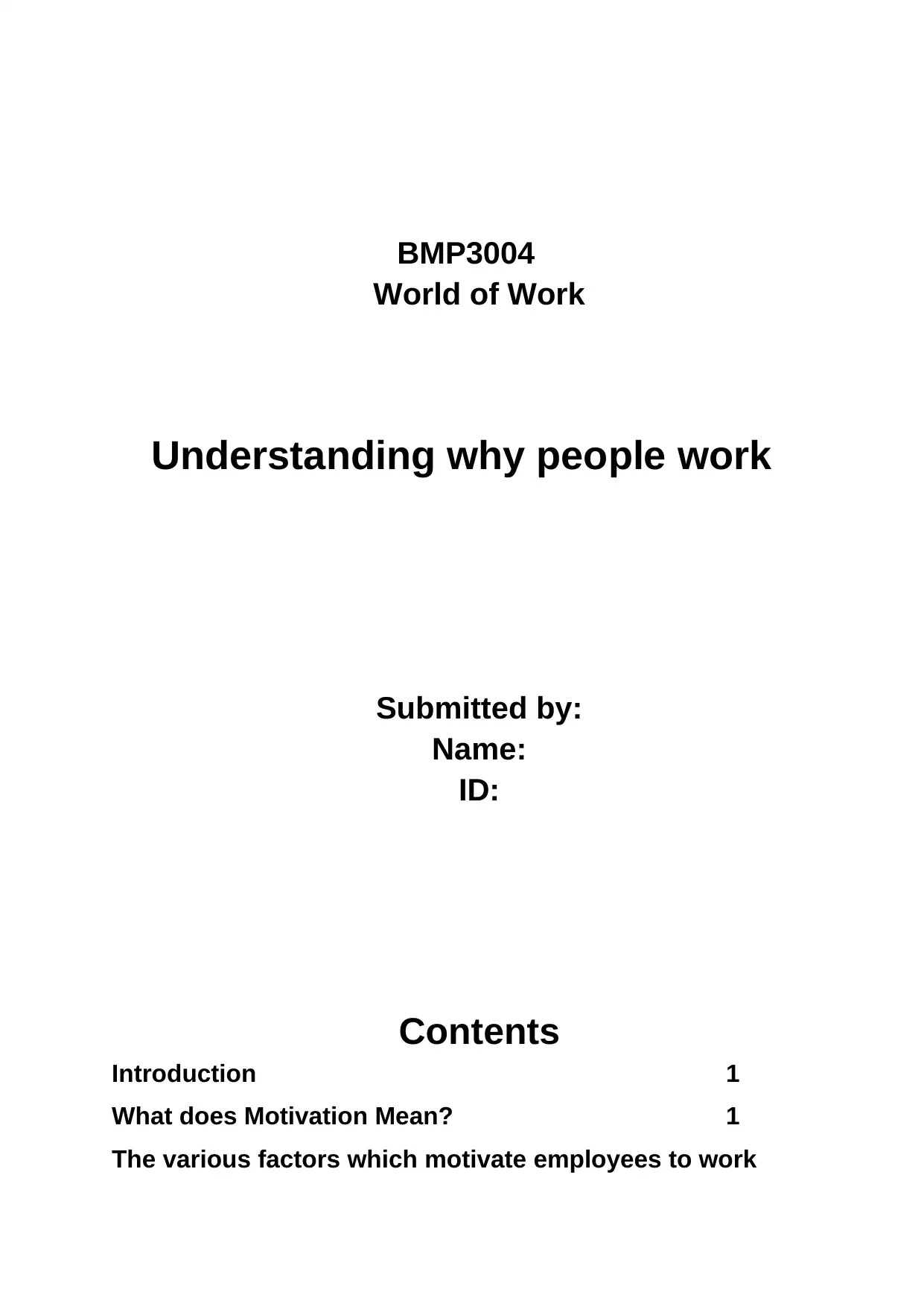
BMP3004
World of Work
Understanding why people work
Submitted by:
Name:
ID:
Contents
Introduction 1
What does Motivation Mean? 1
The various factors which motivate employees to work
World of Work
Understanding why people work
Submitted by:
Name:
ID:
Contents
Introduction 1
What does Motivation Mean? 1
The various factors which motivate employees to work
Paraphrase This Document
Need a fresh take? Get an instant paraphrase of this document with our AI Paraphraser
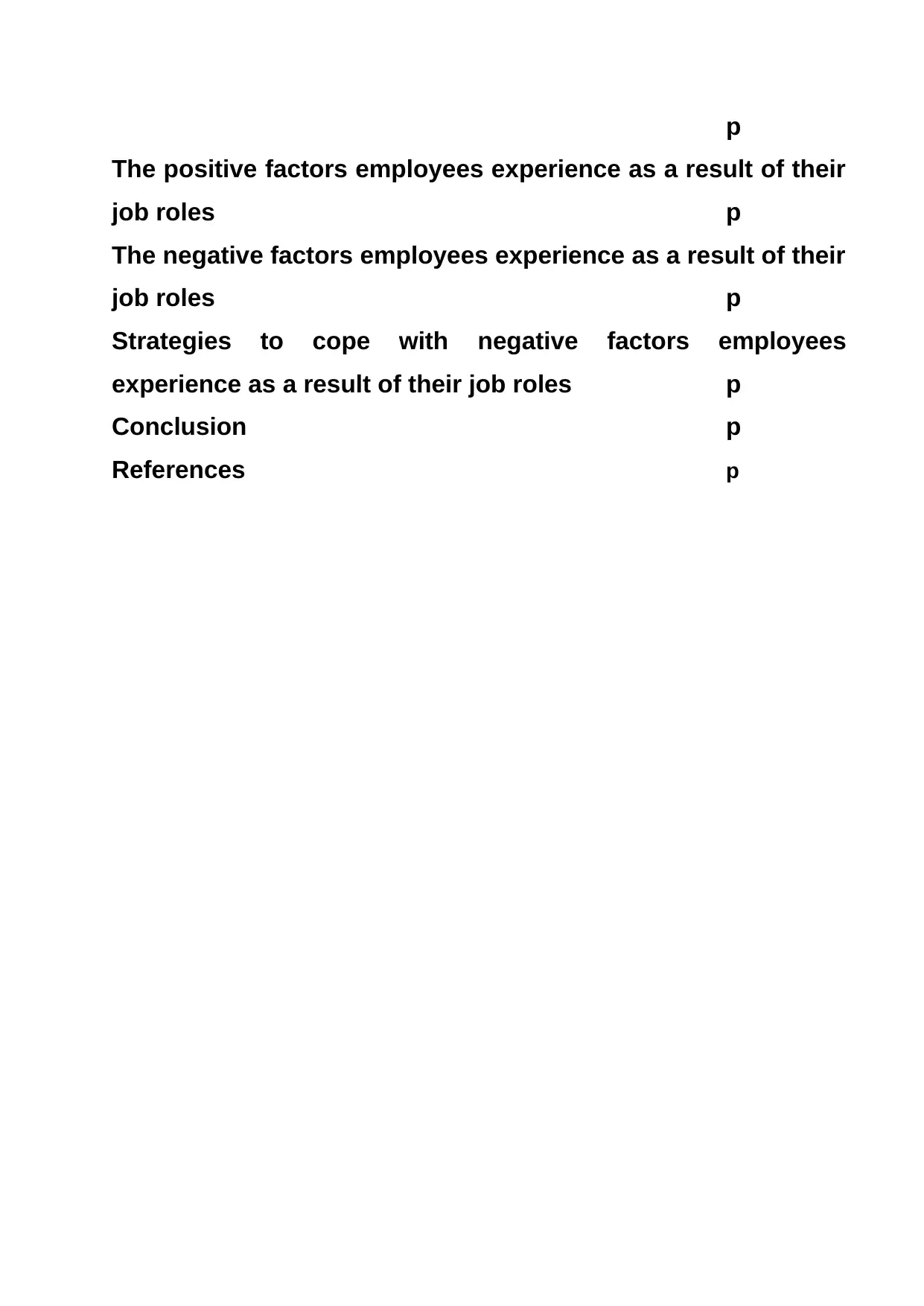
p
The positive factors employees experience as a result of their
job roles p
The negative factors employees experience as a result of their
job roles p
Strategies to cope with negative factors employees
experience as a result of their job roles p
Conclusion p
References p
The positive factors employees experience as a result of their
job roles p
The negative factors employees experience as a result of their
job roles p
Strategies to cope with negative factors employees
experience as a result of their job roles p
Conclusion p
References p
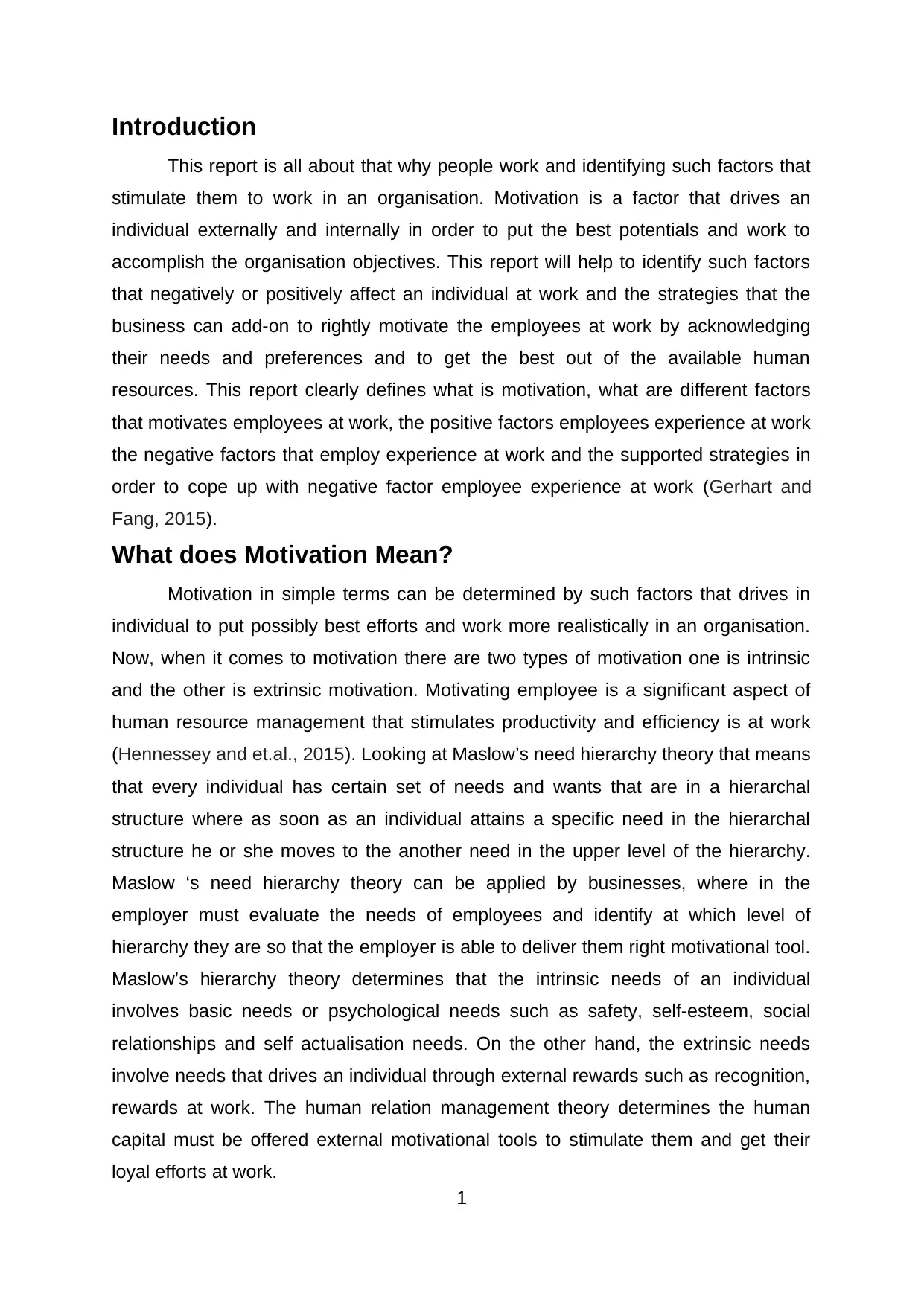
Introduction
This report is all about that why people work and identifying such factors that
stimulate them to work in an organisation. Motivation is a factor that drives an
individual externally and internally in order to put the best potentials and work to
accomplish the organisation objectives. This report will help to identify such factors
that negatively or positively affect an individual at work and the strategies that the
business can add-on to rightly motivate the employees at work by acknowledging
their needs and preferences and to get the best out of the available human
resources. This report clearly defines what is motivation, what are different factors
that motivates employees at work, the positive factors employees experience at work
the negative factors that employ experience at work and the supported strategies in
order to cope up with negative factor employee experience at work (Gerhart and
Fang, 2015).
What does Motivation Mean?
Motivation in simple terms can be determined by such factors that drives in
individual to put possibly best efforts and work more realistically in an organisation.
Now, when it comes to motivation there are two types of motivation one is intrinsic
and the other is extrinsic motivation. Motivating employee is a significant aspect of
human resource management that stimulates productivity and efficiency is at work
(Hennessey and et.al., 2015). Looking at Maslow’s need hierarchy theory that means
that every individual has certain set of needs and wants that are in a hierarchal
structure where as soon as an individual attains a specific need in the hierarchal
structure he or she moves to the another need in the upper level of the hierarchy.
Maslow ‘s need hierarchy theory can be applied by businesses, where in the
employer must evaluate the needs of employees and identify at which level of
hierarchy they are so that the employer is able to deliver them right motivational tool.
Maslow’s hierarchy theory determines that the intrinsic needs of an individual
involves basic needs or psychological needs such as safety, self-esteem, social
relationships and self actualisation needs. On the other hand, the extrinsic needs
involve needs that drives an individual through external rewards such as recognition,
rewards at work. The human relation management theory determines the human
capital must be offered external motivational tools to stimulate them and get their
loyal efforts at work.
1
This report is all about that why people work and identifying such factors that
stimulate them to work in an organisation. Motivation is a factor that drives an
individual externally and internally in order to put the best potentials and work to
accomplish the organisation objectives. This report will help to identify such factors
that negatively or positively affect an individual at work and the strategies that the
business can add-on to rightly motivate the employees at work by acknowledging
their needs and preferences and to get the best out of the available human
resources. This report clearly defines what is motivation, what are different factors
that motivates employees at work, the positive factors employees experience at work
the negative factors that employ experience at work and the supported strategies in
order to cope up with negative factor employee experience at work (Gerhart and
Fang, 2015).
What does Motivation Mean?
Motivation in simple terms can be determined by such factors that drives in
individual to put possibly best efforts and work more realistically in an organisation.
Now, when it comes to motivation there are two types of motivation one is intrinsic
and the other is extrinsic motivation. Motivating employee is a significant aspect of
human resource management that stimulates productivity and efficiency is at work
(Hennessey and et.al., 2015). Looking at Maslow’s need hierarchy theory that means
that every individual has certain set of needs and wants that are in a hierarchal
structure where as soon as an individual attains a specific need in the hierarchal
structure he or she moves to the another need in the upper level of the hierarchy.
Maslow ‘s need hierarchy theory can be applied by businesses, where in the
employer must evaluate the needs of employees and identify at which level of
hierarchy they are so that the employer is able to deliver them right motivational tool.
Maslow’s hierarchy theory determines that the intrinsic needs of an individual
involves basic needs or psychological needs such as safety, self-esteem, social
relationships and self actualisation needs. On the other hand, the extrinsic needs
involve needs that drives an individual through external rewards such as recognition,
rewards at work. The human relation management theory determines the human
capital must be offered external motivational tools to stimulate them and get their
loyal efforts at work.
1
⊘ This is a preview!⊘
Do you want full access?
Subscribe today to unlock all pages.

Trusted by 1+ million students worldwide
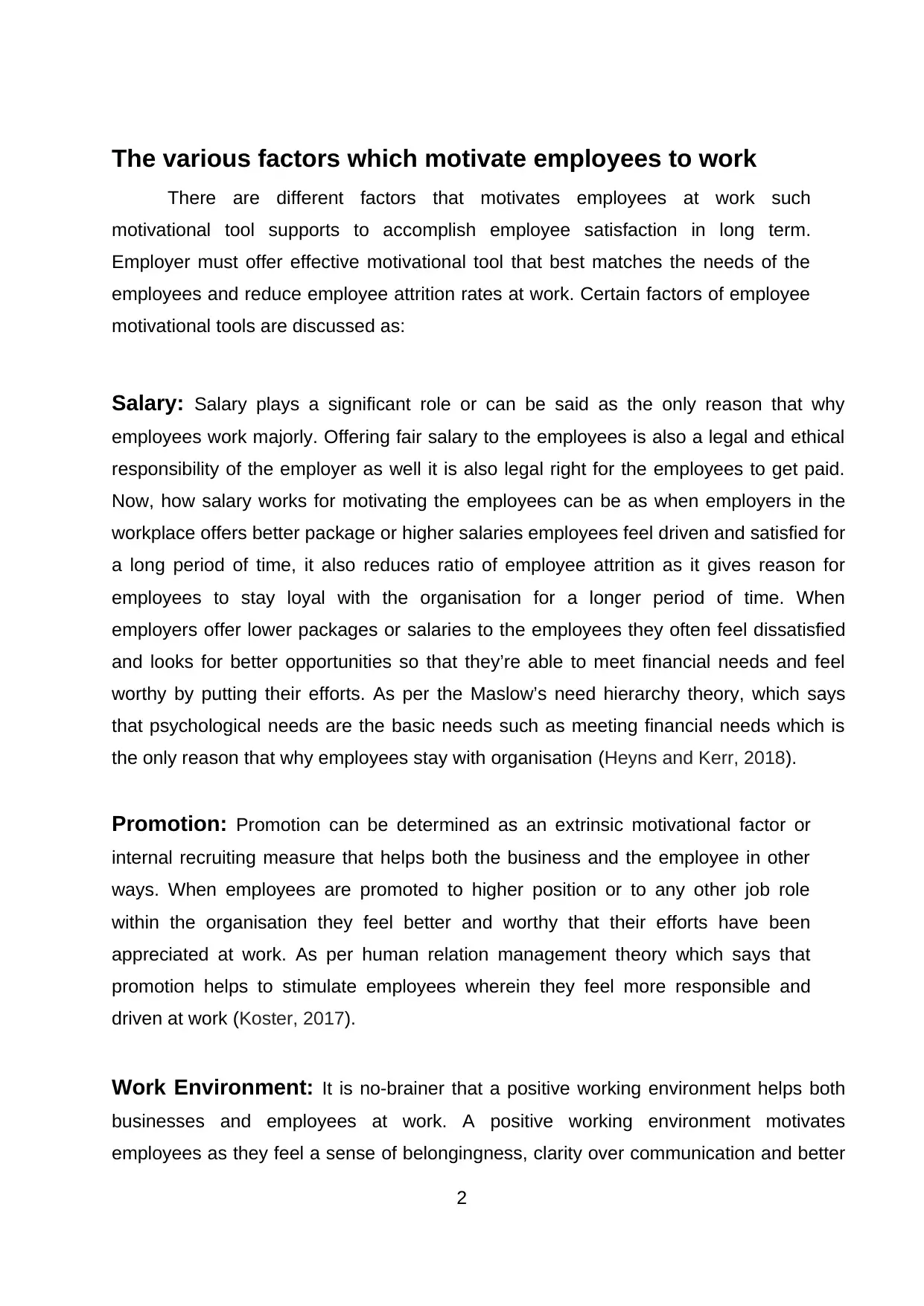
The various factors which motivate employees to work
There are different factors that motivates employees at work such
motivational tool supports to accomplish employee satisfaction in long term.
Employer must offer effective motivational tool that best matches the needs of the
employees and reduce employee attrition rates at work. Certain factors of employee
motivational tools are discussed as:
Salary: Salary plays a significant role or can be said as the only reason that why
employees work majorly. Offering fair salary to the employees is also a legal and ethical
responsibility of the employer as well it is also legal right for the employees to get paid.
Now, how salary works for motivating the employees can be as when employers in the
workplace offers better package or higher salaries employees feel driven and satisfied for
a long period of time, it also reduces ratio of employee attrition as it gives reason for
employees to stay loyal with the organisation for a longer period of time. When
employers offer lower packages or salaries to the employees they often feel dissatisfied
and looks for better opportunities so that they’re able to meet financial needs and feel
worthy by putting their efforts. As per the Maslow’s need hierarchy theory, which says
that psychological needs are the basic needs such as meeting financial needs which is
the only reason that why employees stay with organisation (Heyns and Kerr, 2018).
Promotion: Promotion can be determined as an extrinsic motivational factor or
internal recruiting measure that helps both the business and the employee in other
ways. When employees are promoted to higher position or to any other job role
within the organisation they feel better and worthy that their efforts have been
appreciated at work. As per human relation management theory which says that
promotion helps to stimulate employees wherein they feel more responsible and
driven at work (Koster, 2017).
Work Environment: It is no-brainer that a positive working environment helps both
businesses and employees at work. A positive working environment motivates
employees as they feel a sense of belongingness, clarity over communication and better
2
There are different factors that motivates employees at work such
motivational tool supports to accomplish employee satisfaction in long term.
Employer must offer effective motivational tool that best matches the needs of the
employees and reduce employee attrition rates at work. Certain factors of employee
motivational tools are discussed as:
Salary: Salary plays a significant role or can be said as the only reason that why
employees work majorly. Offering fair salary to the employees is also a legal and ethical
responsibility of the employer as well it is also legal right for the employees to get paid.
Now, how salary works for motivating the employees can be as when employers in the
workplace offers better package or higher salaries employees feel driven and satisfied for
a long period of time, it also reduces ratio of employee attrition as it gives reason for
employees to stay loyal with the organisation for a longer period of time. When
employers offer lower packages or salaries to the employees they often feel dissatisfied
and looks for better opportunities so that they’re able to meet financial needs and feel
worthy by putting their efforts. As per the Maslow’s need hierarchy theory, which says
that psychological needs are the basic needs such as meeting financial needs which is
the only reason that why employees stay with organisation (Heyns and Kerr, 2018).
Promotion: Promotion can be determined as an extrinsic motivational factor or
internal recruiting measure that helps both the business and the employee in other
ways. When employees are promoted to higher position or to any other job role
within the organisation they feel better and worthy that their efforts have been
appreciated at work. As per human relation management theory which says that
promotion helps to stimulate employees wherein they feel more responsible and
driven at work (Koster, 2017).
Work Environment: It is no-brainer that a positive working environment helps both
businesses and employees at work. A positive working environment motivates
employees as they feel a sense of belongingness, clarity over communication and better
2
Paraphrase This Document
Need a fresh take? Get an instant paraphrase of this document with our AI Paraphraser
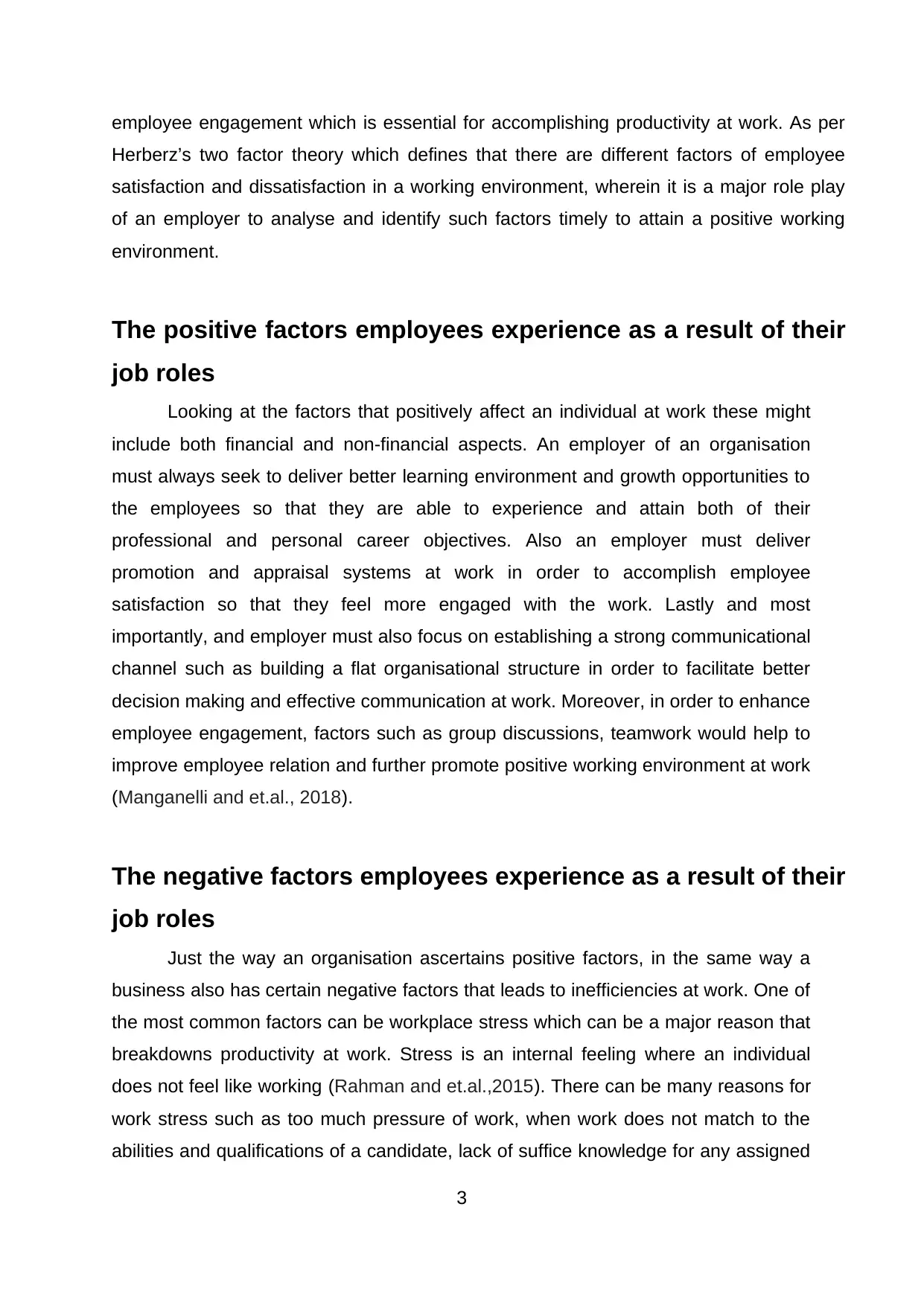
employee engagement which is essential for accomplishing productivity at work. As per
Herberz’s two factor theory which defines that there are different factors of employee
satisfaction and dissatisfaction in a working environment, wherein it is a major role play
of an employer to analyse and identify such factors timely to attain a positive working
environment.
The positive factors employees experience as a result of their
job roles
Looking at the factors that positively affect an individual at work these might
include both financial and non-financial aspects. An employer of an organisation
must always seek to deliver better learning environment and growth opportunities to
the employees so that they are able to experience and attain both of their
professional and personal career objectives. Also an employer must deliver
promotion and appraisal systems at work in order to accomplish employee
satisfaction so that they feel more engaged with the work. Lastly and most
importantly, and employer must also focus on establishing a strong communicational
channel such as building a flat organisational structure in order to facilitate better
decision making and effective communication at work. Moreover, in order to enhance
employee engagement, factors such as group discussions, teamwork would help to
improve employee relation and further promote positive working environment at work
(Manganelli and et.al., 2018).
The negative factors employees experience as a result of their
job roles
Just the way an organisation ascertains positive factors, in the same way a
business also has certain negative factors that leads to inefficiencies at work. One of
the most common factors can be workplace stress which can be a major reason that
breakdowns productivity at work. Stress is an internal feeling where an individual
does not feel like working (Rahman and et.al.,2015). There can be many reasons for
work stress such as too much pressure of work, when work does not match to the
abilities and qualifications of a candidate, lack of suffice knowledge for any assigned
3
Herberz’s two factor theory which defines that there are different factors of employee
satisfaction and dissatisfaction in a working environment, wherein it is a major role play
of an employer to analyse and identify such factors timely to attain a positive working
environment.
The positive factors employees experience as a result of their
job roles
Looking at the factors that positively affect an individual at work these might
include both financial and non-financial aspects. An employer of an organisation
must always seek to deliver better learning environment and growth opportunities to
the employees so that they are able to experience and attain both of their
professional and personal career objectives. Also an employer must deliver
promotion and appraisal systems at work in order to accomplish employee
satisfaction so that they feel more engaged with the work. Lastly and most
importantly, and employer must also focus on establishing a strong communicational
channel such as building a flat organisational structure in order to facilitate better
decision making and effective communication at work. Moreover, in order to enhance
employee engagement, factors such as group discussions, teamwork would help to
improve employee relation and further promote positive working environment at work
(Manganelli and et.al., 2018).
The negative factors employees experience as a result of their
job roles
Just the way an organisation ascertains positive factors, in the same way a
business also has certain negative factors that leads to inefficiencies at work. One of
the most common factors can be workplace stress which can be a major reason that
breakdowns productivity at work. Stress is an internal feeling where an individual
does not feel like working (Rahman and et.al.,2015). There can be many reasons for
work stress such as too much pressure of work, when work does not match to the
abilities and qualifications of a candidate, lack of suffice knowledge for any assigned
3
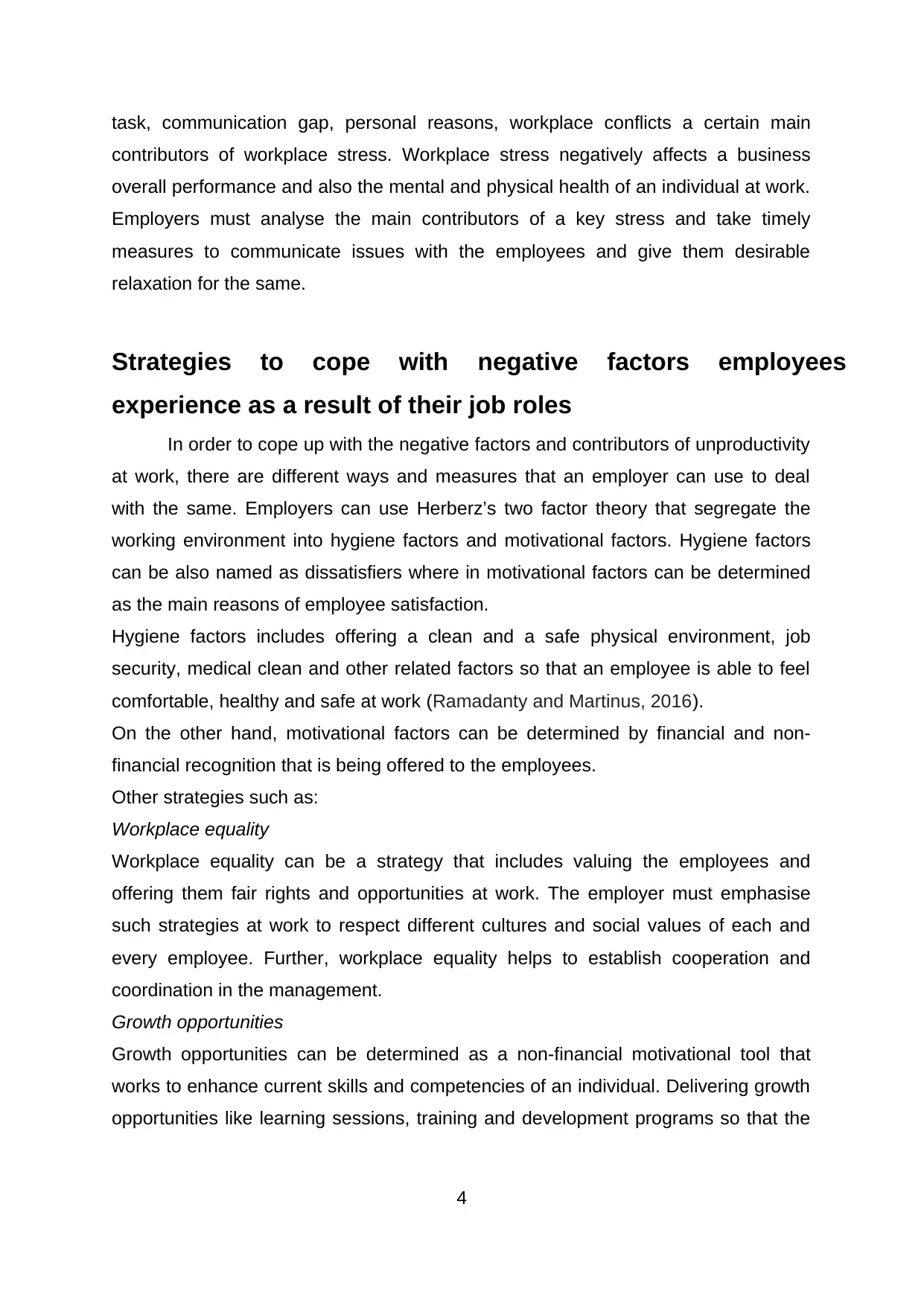
task, communication gap, personal reasons, workplace conflicts a certain main
contributors of workplace stress. Workplace stress negatively affects a business
overall performance and also the mental and physical health of an individual at work.
Employers must analyse the main contributors of a key stress and take timely
measures to communicate issues with the employees and give them desirable
relaxation for the same.
Strategies to cope with negative factors employees
experience as a result of their job roles
In order to cope up with the negative factors and contributors of unproductivity
at work, there are different ways and measures that an employer can use to deal
with the same. Employers can use Herberz’s two factor theory that segregate the
working environment into hygiene factors and motivational factors. Hygiene factors
can be also named as dissatisfiers where in motivational factors can be determined
as the main reasons of employee satisfaction.
Hygiene factors includes offering a clean and a safe physical environment, job
security, medical clean and other related factors so that an employee is able to feel
comfortable, healthy and safe at work (Ramadanty and Martinus, 2016).
On the other hand, motivational factors can be determined by financial and non-
financial recognition that is being offered to the employees.
Other strategies such as:
Workplace equality
Workplace equality can be a strategy that includes valuing the employees and
offering them fair rights and opportunities at work. The employer must emphasise
such strategies at work to respect different cultures and social values of each and
every employee. Further, workplace equality helps to establish cooperation and
coordination in the management.
Growth opportunities
Growth opportunities can be determined as a non-financial motivational tool that
works to enhance current skills and competencies of an individual. Delivering growth
opportunities like learning sessions, training and development programs so that the
4
contributors of workplace stress. Workplace stress negatively affects a business
overall performance and also the mental and physical health of an individual at work.
Employers must analyse the main contributors of a key stress and take timely
measures to communicate issues with the employees and give them desirable
relaxation for the same.
Strategies to cope with negative factors employees
experience as a result of their job roles
In order to cope up with the negative factors and contributors of unproductivity
at work, there are different ways and measures that an employer can use to deal
with the same. Employers can use Herberz’s two factor theory that segregate the
working environment into hygiene factors and motivational factors. Hygiene factors
can be also named as dissatisfiers where in motivational factors can be determined
as the main reasons of employee satisfaction.
Hygiene factors includes offering a clean and a safe physical environment, job
security, medical clean and other related factors so that an employee is able to feel
comfortable, healthy and safe at work (Ramadanty and Martinus, 2016).
On the other hand, motivational factors can be determined by financial and non-
financial recognition that is being offered to the employees.
Other strategies such as:
Workplace equality
Workplace equality can be a strategy that includes valuing the employees and
offering them fair rights and opportunities at work. The employer must emphasise
such strategies at work to respect different cultures and social values of each and
every employee. Further, workplace equality helps to establish cooperation and
coordination in the management.
Growth opportunities
Growth opportunities can be determined as a non-financial motivational tool that
works to enhance current skills and competencies of an individual. Delivering growth
opportunities like learning sessions, training and development programs so that the
4
⊘ This is a preview!⊘
Do you want full access?
Subscribe today to unlock all pages.

Trusted by 1+ million students worldwide
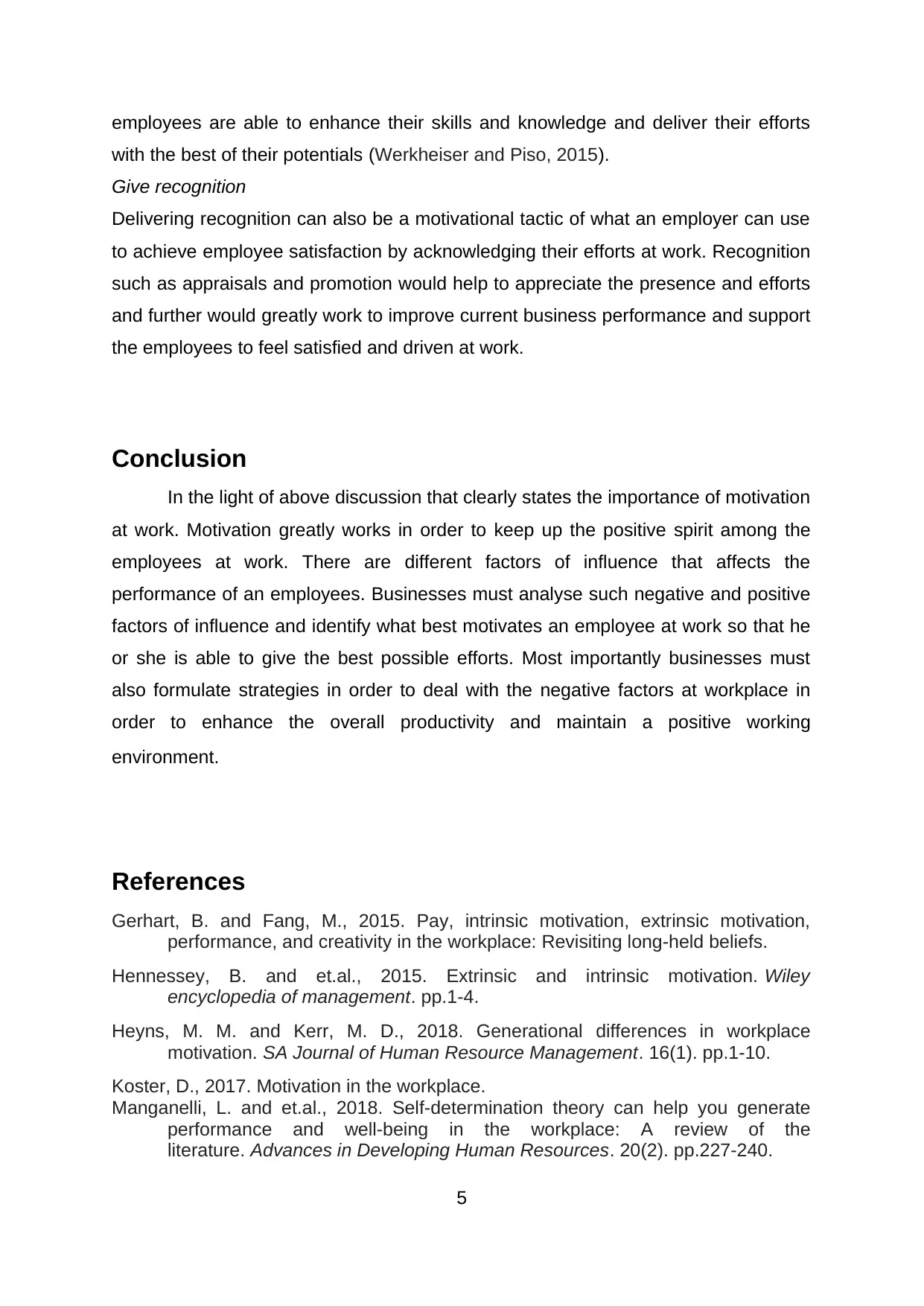
employees are able to enhance their skills and knowledge and deliver their efforts
with the best of their potentials (Werkheiser and Piso, 2015).
Give recognition
Delivering recognition can also be a motivational tactic of what an employer can use
to achieve employee satisfaction by acknowledging their efforts at work. Recognition
such as appraisals and promotion would help to appreciate the presence and efforts
and further would greatly work to improve current business performance and support
the employees to feel satisfied and driven at work.
Conclusion
In the light of above discussion that clearly states the importance of motivation
at work. Motivation greatly works in order to keep up the positive spirit among the
employees at work. There are different factors of influence that affects the
performance of an employees. Businesses must analyse such negative and positive
factors of influence and identify what best motivates an employee at work so that he
or she is able to give the best possible efforts. Most importantly businesses must
also formulate strategies in order to deal with the negative factors at workplace in
order to enhance the overall productivity and maintain a positive working
environment.
References
Gerhart, B. and Fang, M., 2015. Pay, intrinsic motivation, extrinsic motivation,
performance, and creativity in the workplace: Revisiting long-held beliefs.
Hennessey, B. and et.al., 2015. Extrinsic and intrinsic motivation. Wiley
encyclopedia of management. pp.1-4.
Heyns, M. M. and Kerr, M. D., 2018. Generational differences in workplace
motivation. SA Journal of Human Resource Management. 16(1). pp.1-10.
Koster, D., 2017. Motivation in the workplace.
Manganelli, L. and et.al., 2018. Self-determination theory can help you generate
performance and well-being in the workplace: A review of the
literature. Advances in Developing Human Resources. 20(2). pp.227-240.
5
with the best of their potentials (Werkheiser and Piso, 2015).
Give recognition
Delivering recognition can also be a motivational tactic of what an employer can use
to achieve employee satisfaction by acknowledging their efforts at work. Recognition
such as appraisals and promotion would help to appreciate the presence and efforts
and further would greatly work to improve current business performance and support
the employees to feel satisfied and driven at work.
Conclusion
In the light of above discussion that clearly states the importance of motivation
at work. Motivation greatly works in order to keep up the positive spirit among the
employees at work. There are different factors of influence that affects the
performance of an employees. Businesses must analyse such negative and positive
factors of influence and identify what best motivates an employee at work so that he
or she is able to give the best possible efforts. Most importantly businesses must
also formulate strategies in order to deal with the negative factors at workplace in
order to enhance the overall productivity and maintain a positive working
environment.
References
Gerhart, B. and Fang, M., 2015. Pay, intrinsic motivation, extrinsic motivation,
performance, and creativity in the workplace: Revisiting long-held beliefs.
Hennessey, B. and et.al., 2015. Extrinsic and intrinsic motivation. Wiley
encyclopedia of management. pp.1-4.
Heyns, M. M. and Kerr, M. D., 2018. Generational differences in workplace
motivation. SA Journal of Human Resource Management. 16(1). pp.1-10.
Koster, D., 2017. Motivation in the workplace.
Manganelli, L. and et.al., 2018. Self-determination theory can help you generate
performance and well-being in the workplace: A review of the
literature. Advances in Developing Human Resources. 20(2). pp.227-240.
5
Paraphrase This Document
Need a fresh take? Get an instant paraphrase of this document with our AI Paraphraser
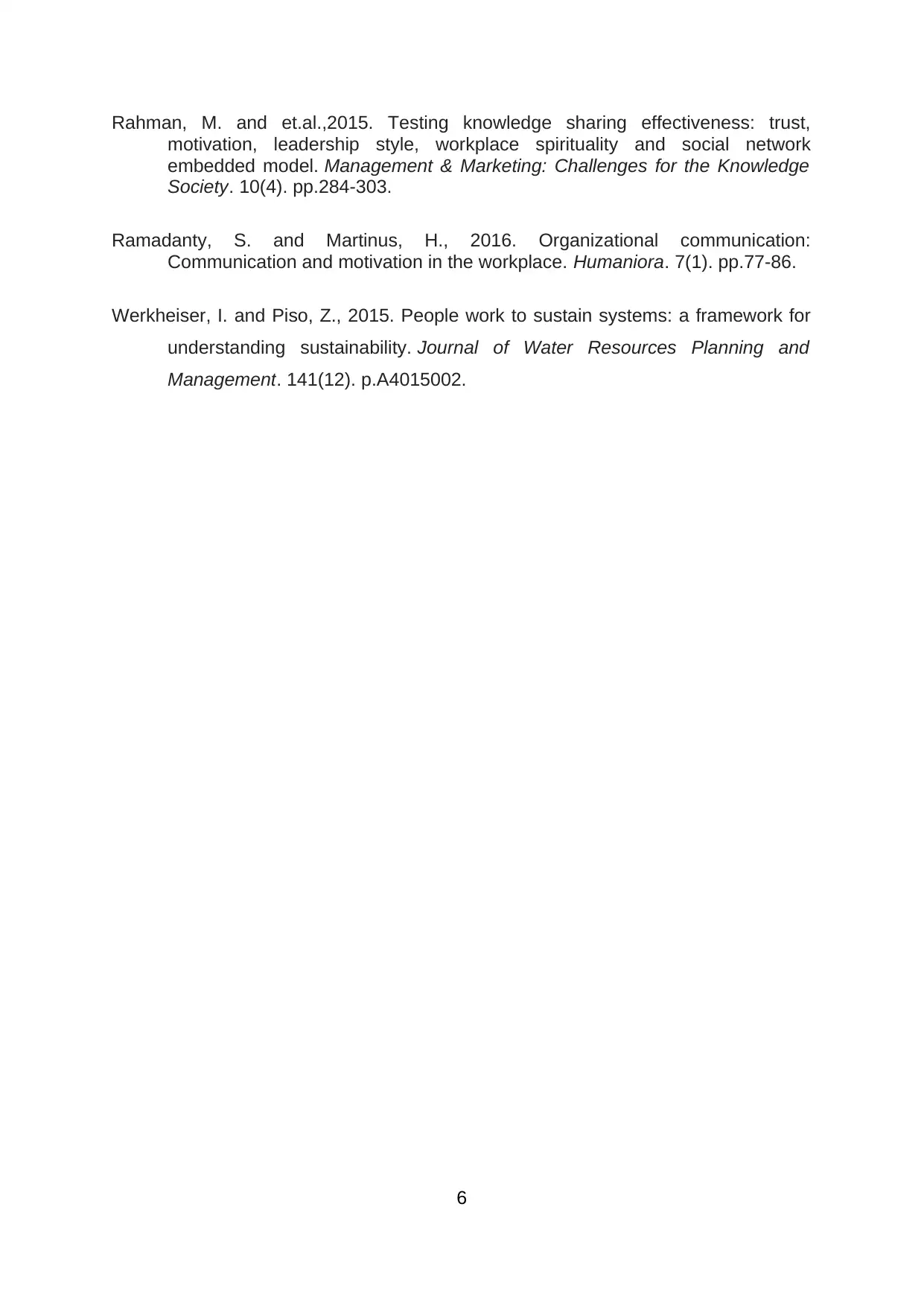
Rahman, M. and et.al.,2015. Testing knowledge sharing effectiveness: trust,
motivation, leadership style, workplace spirituality and social network
embedded model. Management & Marketing: Challenges for the Knowledge
Society. 10(4). pp.284-303.
Ramadanty, S. and Martinus, H., 2016. Organizational communication:
Communication and motivation in the workplace. Humaniora. 7(1). pp.77-86.
Werkheiser, I. and Piso, Z., 2015. People work to sustain systems: a framework for
understanding sustainability. Journal of Water Resources Planning and
Management. 141(12). p.A4015002.
6
motivation, leadership style, workplace spirituality and social network
embedded model. Management & Marketing: Challenges for the Knowledge
Society. 10(4). pp.284-303.
Ramadanty, S. and Martinus, H., 2016. Organizational communication:
Communication and motivation in the workplace. Humaniora. 7(1). pp.77-86.
Werkheiser, I. and Piso, Z., 2015. People work to sustain systems: a framework for
understanding sustainability. Journal of Water Resources Planning and
Management. 141(12). p.A4015002.
6
1 out of 8
Related Documents
Your All-in-One AI-Powered Toolkit for Academic Success.
+13062052269
info@desklib.com
Available 24*7 on WhatsApp / Email
![[object Object]](/_next/static/media/star-bottom.7253800d.svg)
Unlock your academic potential
Copyright © 2020–2025 A2Z Services. All Rights Reserved. Developed and managed by ZUCOL.



